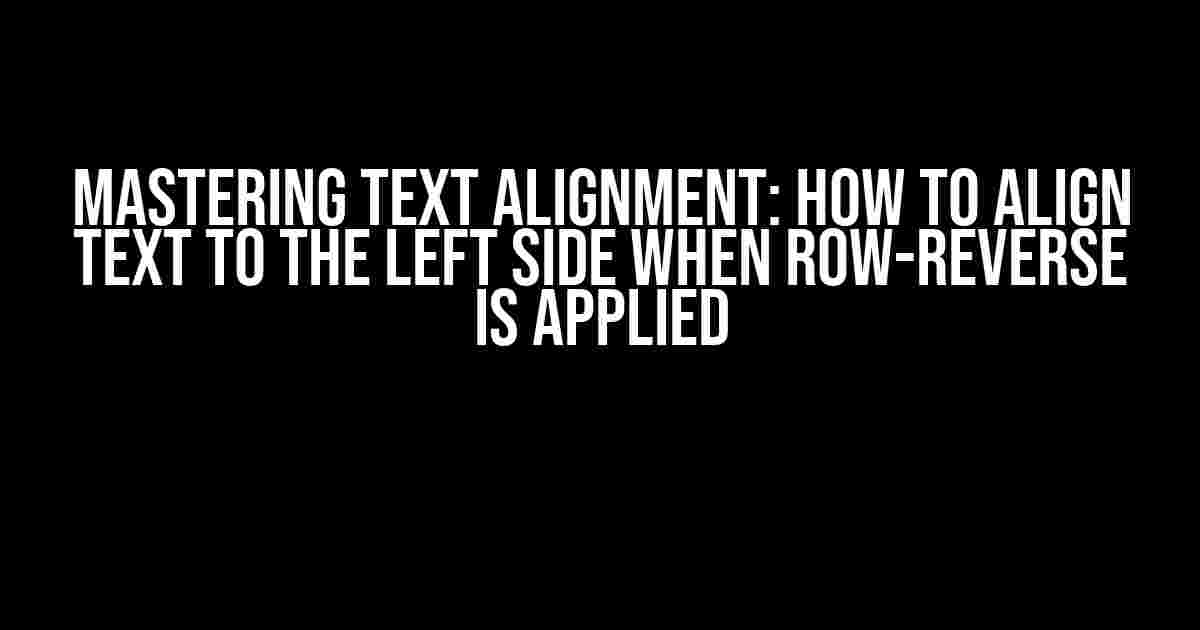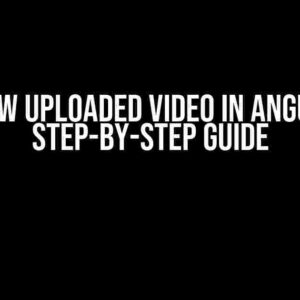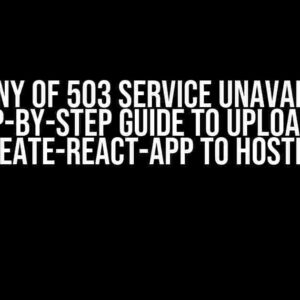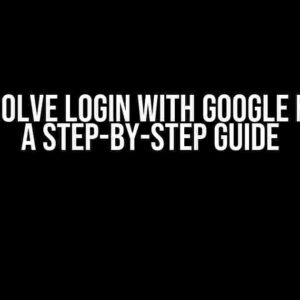Are you tired of struggling with text alignment issues when using flexbox with the row-reverse property? Do you find yourself scratching your head, wondering why your text insists on sticking to the right side of the container? Fear not, dear developer! In this comprehensive guide, we’ll delve into the world of text alignment and show you how to tame the beast that is row-reverse.
Understanding Flexbox and Row-Reverse
Before we dive into the solution, let’s take a step back and understand the concept of flexbox and row-reverse. Flexbox, short for flexible box, is a layout mode that allows you to create flexible layouts that adapt to different screen sizes and devices. It’s an essential tool for any modern web developer.
Row-reverse, on the other hand, is a property that reverses the direction of the flex items. Instead of aligning items from left to right, row-reverse aligns them from right to left. This property is especially useful when creating responsive layouts or when you need to change the direction of your content.
The Problem: Text Alignment Issues with Row-Reverse
When you apply row-reverse to a flex container, the text within that container becomes right-aligned by default. This can be problematic, especially when you want the text to align to the left side of the container. So, how do you overcome this issue?
Solution 1: Using the `text-align` Property
The simplest way to align text to the left side when row-reverse is applied is to use the `text-align` property. You can add the following code to your CSS:
flex-container {
display: flex;
flex-direction: row-reverse;
text-align: left;
}This will align the text within the container to the left side, regardless of the row-reverse property. Easy peasy, right?
Solution 2: Using the `justify-content` Property
Another way to align text to the left side is to use the `justify-content` property. You can add the following code to your CSS:
flex-container {
display: flex;
flex-direction: row-reverse;
justify-content: flex-start;
}The `justify-content` property controls how flex items are aligned along the main axis. By setting it to `flex-start`, you’re essentially telling the browser to align the items to the left side of the container.
Solution 3: Using the `margin` Property
If you want to get a bit more creative, you can use the `margin` property to align text to the left side. You can add the following code to your CSS:
flex-item {
margin: 0 0 0 auto;
}This will set the left margin of the flex item to `auto`, which will push the item to the left side of the container. Note that this solution requires you to apply it to the flex item itself, not the container.
Advanced Techniques: Combining Properties
Sometimes, you might need to combine multiple properties to achieve the desired text alignment. Let’s take a look at a few examples:
Example 1: Combining `text-align` and `justify-content`
Say you want to align text to the left side and also justify the content within the container. You can combine the `text-align` and `justify-content` properties like so:
flex-container {
display: flex;
flex-direction: row-reverse;
text-align: left;
justify-content: space-between;
}This will align the text to the left side and distribute the remaining space evenly between the flex items.
Example 2: Combining `margin` and `justify-content`
Alternatively, you can combine the `margin` and `justify-content` properties to achieve a similar effect:
flex-item {
margin: 0 0 0 auto;
}
flex-container {
display: flex;
flex-direction: row-reverse;
justify-content: space-between;
}This will set the left margin of the flex item to `auto`, pushing it to the left side of the container, while also distributing the remaining space evenly between the flex items.
Common Mistakes to Avoid
When working with flexbox and row-reverse, it’s easy to fall into common pitfalls. Here are a few mistakes to avoid:
- Not setting the `display` property to `flex`: Make sure you set the `display` property to `flex` on the container element. Otherwise, the flexbox properties won’t take effect.
- Not applying the `flex-direction` property correctly: Remember to set the `flex-direction` property to `row-reverse` to reverse the direction of the flex items.
- Not considering the `text-align` property: Don’t forget to set the `text-align` property to `left` to align the text within the container.
Conclusion
In conclusion, aligning text to the left side when row-reverse is applied is a challenge that can be overcome with a few simple CSS tricks. By using the `text-align`, `justify-content`, or `margin` properties, you can achieve the desired text alignment and create beautiful, responsive layouts. Remember to avoid common mistakes and combine properties creatively to take your flexbox skills to the next level.
| Property | Description |
|---|---|
| `text-align` | Aligns text within a container |
| `justify-content` | Controls how flex items are aligned along the main axis |
| `margin` | Sets the margin of an element |
| `flex-direction` | Sets the direction of the flex items |
| `display` | Sets the display type of an element |
With these tips and tricks up your sleeve, you’ll be well on your way to mastering flexbox and row-reverse. Happy coding!
FAQs
-
Q: Can I use `float` instead of flexbox?
A: No, `float` is not recommended for aligning text within a container. Flexbox is a more modern and flexible approach to layout design.
-
Q: Will these solutions work in older browsers?
A: Flexbox is supported in most modern browsers, including Chrome, Firefox, Safari, and Edge. However, older browsers may not support certain properties or values. Always check the browser compatibility before implementing flexbox solutions.
-
Q: Can I use these techniques with other layout modes?
A: Yes, these techniques can be adapted for use with other layout modes, such as grid or inline-block. However, the specific properties and values may vary depending on the layout mode.
We hope this article has helped you master the art of aligning text to the left side when row-reverse is applied. Remember to practice, experiment, and have fun with flexbox!
Frequently Asked Question
Hey there, fellow coders! Are you struggling to align your text to the left side when using flexbox’s row-reverse property? Worry no more, because we’ve got you covered! Here are some FAQs to help you solve this common issue:
Q: Why does my text align to the right side when I use row-reverse?
When you use flexbox’s row-reverse property, it reverses the direction of the flex items, but it doesn’t change the default alignment of the text, which is to the right side. To fix this, you need to explicitly set the text-align property to left.
Q: Can I use the justify-content property to align the text to the left side?
No, the justify-content property only controls the alignment of flex items along the main axis, not the text alignment within those items. To align the text to the left side, you need to use the text-align property.
Q: How can I align the text to the left side when using row-reverse?
You can align the text to the left side when using row-reverse by adding the style “text-align: left” to the flex items. This will override the default right alignment and ensure your text is aligned to the left side.
Q: Will setting text-align: left affect the entire container?
No, setting text-align: left will only affect the text within the flex items, not the entire container. The row-reverse property will still reverse the direction of the flex items, but the text within those items will be aligned to the left side.
Q: Is there a trick to remembering how to align text when using row-reverse?
Yes, here’s a trick: whenever you use row-reverse, think “reverse the direction, but not the text alignment”. This will remind you to explicitly set the text-align property to left to get the desired alignment.




